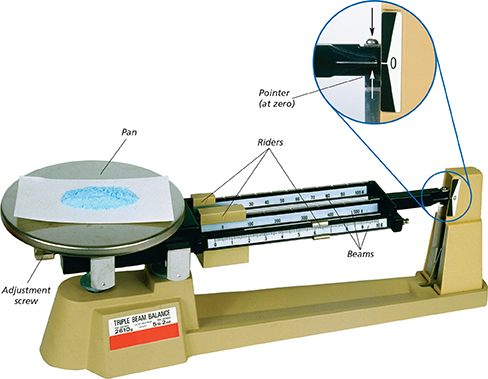Appendix B Using a Laboratory Balance
The laboratory balance is an important tool in scientific investigations. You can use a balance to determine the masses of materials that you study or experiment with in the laboratory.
Different kinds of balances are used in the laboratory. One kind of balance is the triple-beam balance. The balance that you may use in your science class is probably similar to the balance illustrated. To use the balance properly, you should learn the name, location, and function of each part of the balance you are using.
The Triple-Beam Balance
The triple-beam balance is a single-pan balance with three beams The back, or 100-gram, beam is divided into ten units of 10 grams. The middle, or 500-gram, beam is divided into five units of 100 grams. The front, or 10-gram, beam is divided into ten major units, each of which is 1 gram. Each 1-gram unit is further divided into units of 0.1 gram. What is the largest mass you could measure with a triple-beam balance?
The following procedure can be used to find the mass of an object with a triple-beam balance.
When no object is on the pan, and the riders are at zero, make sure the pointer is at zero. If it is not, use the adjustment screw to zero the balance.
Place the object on the pan.
Move the rider on the middle beam notch by notch until the horizontal pointer drops below zero. Move the rider back one notch.
Move the rider on the back beam notch by notch until the pointer again drops below zero. Move the rider back one notch.
Slowly slide the rider along the front beam until the pointer stops at zero. The mass of the object is the sum of the readings on the three beams.
Triple-Beam Balance





